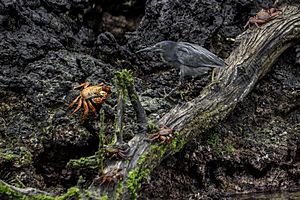Lava heron facts for kids
Quick facts for kids Lava heron |
|
|---|---|
 |
|
| Adult on Santa Fe Island | |
| Scientific classification | |
| Genus: |
Butorides
|
| Species: |
sundevalli
|
| Synonyms | |
|
Butorides striata sundevalli |
|
The lava heron (Butorides sundevalli), also called the Galápagos heron, is a special type of heron. It lives only on the Galápagos Islands in Ecuador. Some experts think it might be a subspecies or even just a different color of the striated heron. Long ago, it was grouped with the striated heron and the green heron as the "green-backed heron."
Contents
What Does the Lava Heron Look Like?
Adult lava herons are dark gray to black. This color helps them hide perfectly among the dark, hardened lava rocks. Their back feathers often look shiny and silver. They also have a short crest of feathers on their heads.
When it's time to breed, the heron's beak turns black and its legs become bright orange. After the breeding season, these colors fade back to gray.
Where Do Lava Herons Live?
These birds are very protective of their homes. You can find them in areas where the ocean meets the land, called intertidal zones. They also live in mangrove swamps. They are found on all the islands of Galápagos Province.
How Do Lava Herons Behave?
What Do Lava Herons Eat?
Lava herons hunt small crabs and fish. They walk very slowly and quietly. Then, they quickly strike to spear and eat their prey. They have also been seen eating flies that gather near cacti. Sometimes, they even eat smaller birds.
How Do Lava Herons Act Around Others?
These birds are not very afraid of humans. They often fly in ways that might be meant to protect their territory. This behavior also helps them show other birds where their home is.
What Do Lava Herons Sound Like?
Lava herons are often seen hunched over. They make a sharp alarm call that sounds like a "scow." If they are acting aggressively, they will use a "skuk-skuk" call.
Lava Heron Reproduction and Life Cycle
Unlike most herons, lava herons build their nests alone. They form pairs for one breeding season. They usually nest in the lower branches of mangrove trees or under lava rocks.
They can breed all year round. However, they are most active from September to March. A pair can mate up to three times a year. Each time, they can lay up to ten eggs.
See also
 In Spanish: Garza enana de las Galápagos para niños
In Spanish: Garza enana de las Galápagos para niños


